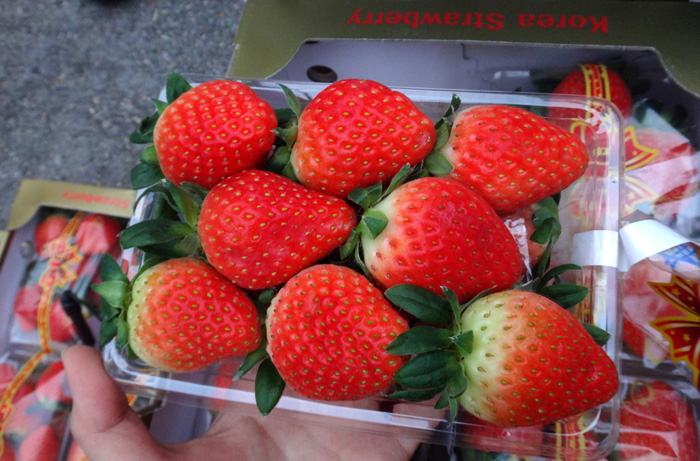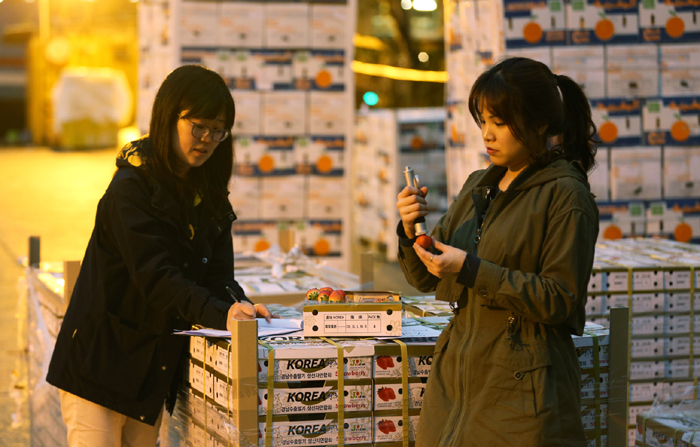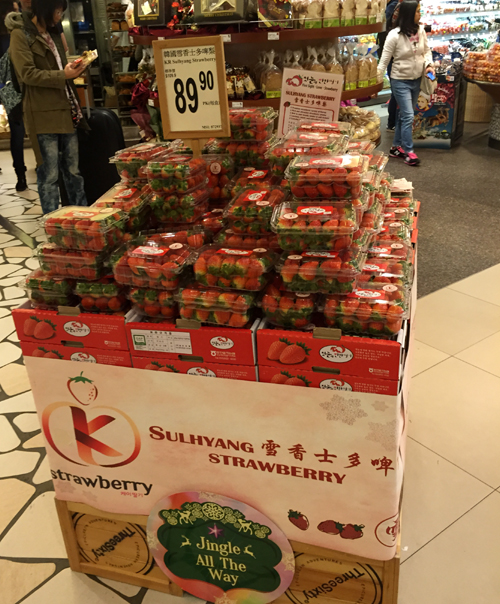"Sulhyang" strawberries, a domestic variety of the tasty fruit, characteristic for their excellent color, taste and size, are now ready to appeal to taste buds across the globe.

The Rural Development Administration (RDA) recently took some Sulhyang strawberries to Hong Kong -- surprisingly, by ship -- to do some test marketing.
Although when compared to air transportation shipping by water has the merits of low cost and high volume, it takes more time, three to ten more days, than air service, which takes less than a day.
In that regard, transporting by ship doesn’t seem suitable for strawberries, a fruit that can easily over-ripen, get soft or rot.
To deal with these problems, a new processing technology has been developed using carbon dioxide. Sulhwa strawberries, when about 70 percent ripe, are put in airtight containers and the carbon dioxide concentration is increased to about 25 to 30 percent for three hours.
As a result, researchers found that the exposure had a great influence on the freshness of the fruit.
Last December, the RDA shipped to Hong Kong boxes of Sulhyang strawberries that had gone through the carbon dioxide process and found that the fruit keeps its freshness, which was otherwise short-lived, for ten days, even after arriving in port.


The fruit stayed more firm than when they were picked, and were less likely to be bruised, maintaining their marketability for two days after they were put on the market.
“Domestic strawberries have made inroads in Southeast Asian markets, including Hong Kong, Singapore, Malaysia and Thailand. Their export volume has increased to USD 29.8 million in 2013, 23 percent up from the USD 24.3 million seen in 2012,” said an official from the RDA.
“With the recent successful shipping to Hong Kong, it now seems feasible to supply our strawberries in a fresher state at substantially lower cost, not only to Hong Kong, but to mainland China, too.”
By Sohn JiAe
Korea.net Staff Writer
Photos: the Rural Development Administration
jiae5853@korea.kr

Sulhyang strawberries are known for their excellent size and taste.
The Rural Development Administration (RDA) recently took some Sulhyang strawberries to Hong Kong -- surprisingly, by ship -- to do some test marketing.
Although when compared to air transportation shipping by water has the merits of low cost and high volume, it takes more time, three to ten more days, than air service, which takes less than a day.
In that regard, transporting by ship doesn’t seem suitable for strawberries, a fruit that can easily over-ripen, get soft or rot.
To deal with these problems, a new processing technology has been developed using carbon dioxide. Sulhwa strawberries, when about 70 percent ripe, are put in airtight containers and the carbon dioxide concentration is increased to about 25 to 30 percent for three hours.
As a result, researchers found that the exposure had a great influence on the freshness of the fruit.
Last December, the RDA shipped to Hong Kong boxes of Sulhyang strawberries that had gone through the carbon dioxide process and found that the fruit keeps its freshness, which was otherwise short-lived, for ten days, even after arriving in port.

Inspectors check the freshness of Sulhyang strawberries as they arrive in Hong Kong after ten days onboard a ship.

Sulhyang strawberries keep their freshness even after days onboard a ship from Korea due to the newly-discovered processing technology using carbon dioxide. Pictured are Sulhyang strawberries on sale at a market in Hong Kong.
The fruit stayed more firm than when they were picked, and were less likely to be bruised, maintaining their marketability for two days after they were put on the market.
“Domestic strawberries have made inroads in Southeast Asian markets, including Hong Kong, Singapore, Malaysia and Thailand. Their export volume has increased to USD 29.8 million in 2013, 23 percent up from the USD 24.3 million seen in 2012,” said an official from the RDA.
“With the recent successful shipping to Hong Kong, it now seems feasible to supply our strawberries in a fresher state at substantially lower cost, not only to Hong Kong, but to mainland China, too.”
By Sohn JiAe
Korea.net Staff Writer
Photos: the Rural Development Administration
jiae5853@korea.kr